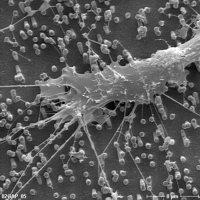
1Medizinische Fakultät der Universität Rostock, Klinik und Poliklinik für Neurologie, D-18147 Rostock, Germany,
2Institute of Biophysics, Faculty of Medicine, University of Ljubljana, Slovenia
3Laboratory of Applied Physics, Faculty of Electrical Engineering, University of Ljubljana, Slovenia
4Fraunhofer IZM Berlin, Dept. Board Interconnection Technologies, D-13355 Berlin, Germany, and
5Institut für Biowissenschaften der Universität Rostock, Lehrstuhl für Biophysik, D-18059 Rostock, Germany
e-mail: ulrike.gimsa@med.uni-rostock.de
URL: http://neurobiology.med.uni-rostock.de/junior_research_group/index.html
